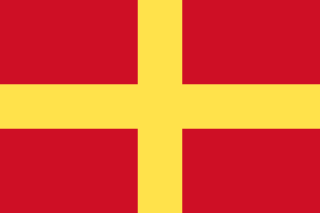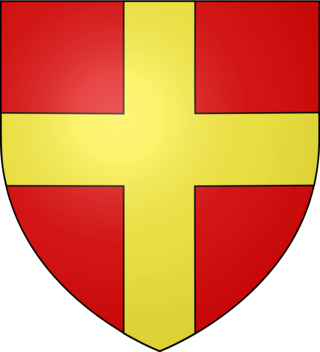
The Kingdom of Jerusalem, also known as the Latin Kingdom, was a Crusader state that was established in the Levant immediately after the First Crusade. It lasted for almost two hundred years, from the accession of Godfrey of Bouillon in 1099 until the fall of Acre in 1291. Its history is divided into two periods with a brief interruption in its existence, beginning with its collapse after the siege of Jerusalem in 1187 and its restoration after the Third Crusade in 1192.

Year 1287 (MCCLXXXVII) was a common year starting on Wednesday of the Julian calendar.

Year 1289 (MCCLXXXIX) was a common year starting on Saturday of the Julian calendar.

The Eighth Crusade was the second Crusade launched by Louis IX of France, this one against the Hafsid dynasty in Tunisia in 1270. It is also known as the Crusade of Louis IX Against Tunis or the Second Crusade of Louis. The Crusade did not see any significant fighting as Louis died of dysentery shortly after arriving on the shores of Tunisia. The Treaty of Tunis was negotiated between the Crusaders and the Hafsids. No changes in territory occurred, though there were commercial and some political rights granted to the Christians. The Crusaders withdrew back to Europe soon after.

Raymond of Saint-Gilles, also called Raymond IV of Toulouse or Raymond I of Tripoli, was the count of Toulouse, duke of Narbonne, and margrave of Provence from 1094, and one of the leaders of the First Crusade from 1096 to 1099. He spent the last five years of his life establishing the County of Tripoli in the Near East.

The County of Tripoli (1102–1289) was one of the Crusader states. It was founded in the Levant in the modern-day region of Tripoli, northern Lebanon and parts of western Syria. When the Frankish Crusaders – mostly southern French forces – captured the region in 1109, Bertrand of Toulouse became the first count of Tripoli as a vassal of King Baldwin I of Jerusalem. From that time, the rule of the county was decided not strictly by inheritance but by factors such as military force, favour and negotiation. In 1289 the County of Tripoli fell to Sultan Qalawun of the Muslim Mamluks of Cairo. The county was absorbed into Mamluk Egypt.
Bohemond VI, also known as the Fair, was the prince of Antioch and count of Tripoli from 1251 until his death. He ruled while Antioch was caught between the warring Mongol Empire and Mamluk Sultanate. He allied with the Mongols against the Muslim Mamluks and his Crusaders fought alongside the Mongols in their battles against the Mamluks. The Mamluks would achieve a historic victory against the Mongols and halt their advance westwards at the Battle of Ain Jalut. In 1268 Antioch was captured by the Mamluks under Baybars, and he was thenceforth a prince in exile. He was succeeded by his son, Bohemond VII.

Lord Edward's Crusade, sometimes called the Ninth Crusade, was a military expedition to the Holy Land under the command of Edward, Duke of Gascony in 1271–1272. It was an extension of the Eighth Crusade and was the last of the Crusades to reach the Holy Land before the fall of Acre in 1291 brought an end to the permanent crusader presence there.

The count of Tripoli was the ruler of the County of Tripoli, a crusader state from 1102 through to 1289. Of the four major crusader states in the Levant, Tripoli was created last.
William II Jordan was the count of Berga beginning in 1094, the count of Cerdanya beginning in 1095, and regent of the County of Tripoli beginning in 1105.

Bohemond VII was the count of Tripoli and nominal prince of Antioch from 1275 to his death. The only part left of the Principality of Antioch was the port of Latakia. He spent much of his reign at war with the Templars (1277–1282).

Qalāwūn aṣ-Ṣāliḥī was the seventh Turkic Bahri Mamluk Sultan of Egypt; he ruled from 1279 to 1290. He was called al-Manṣūr Qalāwūn. After having risen in power in the Mamluk court and elite circles, Qalawun eventually held the title of "the victorious king" and gained de facto authority over the sultanate. He is the founder of the Qalawunid dynasty that ruled Egypt for over a century.

Abaqa Khan, was the second Mongol ruler (Ilkhan) of the Ilkhanate. The son of Hulagu Khan and Lady Yesünčin and the grandson of Tolui, he reigned from 1265 to 1282 and was succeeded by his brother Ahmed Tekuder. Much of Abaqa's reign was consumed with civil wars in the Mongol Empire, such as those between the Ilkhanate and the northern khanate of the Golden Horde. Abaqa also engaged in unsuccessful attempts at invading Syria under the Mamluk Sultanate, which included the Second Battle of Homs.

Al-Ashraf Salāh ad-Dīn Khalil ibn Qalawūn was the eighth Turkic Bahri Mamluk sultan, succeeding his father Qalawun. He served from 12 November 1290 until his assassination in December 1293. He was well known for conquering the last of the Crusader states in Palestine after the siege of Acre in 1291. While walking with a friend, Khalil was attacked and assassinated by Baydara and his followers, who was then killed under the orders of Kitbugha.
Narjotde Toucy was the son of Philip of Toucy and of Portia de Roye. Narjot was therefore the grandson of his namesake who died in 1241.

Guillaume de Beaujeu, aka William of Beaujeu was the 21st Grand Master of the Knights Templar, from 1273 until his death during the siege of Acre in 1291. He was the last Grand Master to preside in Palestine.
Sibylla of Armenia was the princess of Antioch and countess of Tripoli by marriage to Bohemond VI from 1254 to 1275, and then regent of the County of Tripoli until their son, Bohemond VII, came of age in 1277. She was closely allied with the bishop of Tortosa, Bartholomew Mansel, which frustrated the scheme to install her as ruler of Tripoli instead of her daughter Lucia after Bohemond VII's death in 1287. During her lifetime, both the principality and the county were lost to the Egyptian Mamluks.

The Fall of Tripoli was the capture and destruction of the Crusader state, the County of Tripoli, by the Muslim Mamluks. The battle occurred in 1289 and was an important event in the Crusades, as it marked the capture of one of the few remaining major possessions of the Crusaders. The event is represented in a rare surviving illustration from a now fragmentary manuscript known as the 'Cocharelli Codex', thought to have been created in Genoa in the 1330s. The image shows the countess Lucia, Countess of Tripoli and Bartholomew, Bishop of Tortosa sitting in state in the centre of the fortified city, and Qalawun's assault in 1289, with his army depicted massacring the inhabitants fleeing to boats in the harbour and to the nearby island of St Thomas.

The 1271 siege of Tripoli was initiated by the Mamluk ruler Baibars against the Frankish ruler of the Principality of Antioch and the County of Tripoli, Bohemond VI. It followed the dramatic fall of Antioch in 1268, and was an attempt by the Mamluks to completely destroy the Crusader states of Antioch and Tripoli.

The fall of Outremer describes the history of the Kingdom of Jerusalem from the end of the last European Crusade to the Holy Land in 1272 until the final loss in 1302. The kingdom was the center of Outremer—the four Crusader states—formed after the First Crusade in 1099 and reached its peak in 1187. The loss of Jerusalem in that year began the century-long decline. The years 1272–1302 are fraught with many conflicts throughout the Levant as well as the Mediterranean and Western European regions, and many Crusades were proposed to free the Holy Land from Mamluk control. The major players fighting the Muslims included the kings of England and France, the kingdoms of Cyprus and Sicily, the three Military Orders and Mongol Ilkhanate. Traditionally, the end of Western European presence in the Holy Land is identified as their defeat at the Siege of Acre in 1291, but the Christian forces managed to hold on to the small island fortress of Ruad until 1302.
















